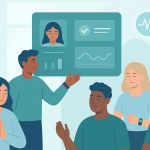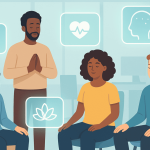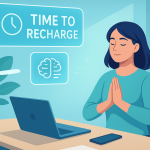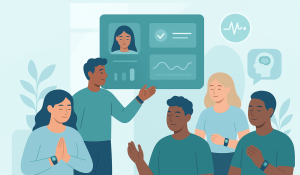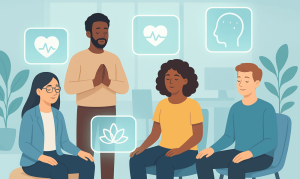Smartphones have transformed the way we communicate, work, and unwind—but they’ve also created an invisible tether that’s increasingly hard to break. For many working professionals, constant notifications, endless scrolling, and app-hopping have made it difficult to disconnect—even after hours. As the boundary between work and life blurs, the risk of digital burnout rises. But can AI for cell phone addiction offer a way out?
This blog explores how AI-powered mindfulness tools are helping reduce screen dependence, improve mental wellbeing, and guide professionals toward a more focused, present, and balanced life.
Why Cell Phone Addiction Is a Growing Concern in the Workplace
Cell phone addiction isn’t just a Gen Z issue—it’s a silent disruptor across industries. Recent studies reveal that:
- The average adult checks their phone 96 times a day—roughly once every 10 minutes.
- 45% of employees report feeling “mentally exhausted” from excessive digital interactions.
- Screen addiction is now linked to higher stress, reduced sleep quality, and lower productivity.
In sectors like tech, healthcare, finance, and construction—where stress is already high—the mental toll of digital overload is even more serious. Leaders are beginning to recognize that helping employees manage their phone usage isn’t a luxury—it’s a necessity.
Enter AI: The New Digital Companion for Reducing Screen Dependence
Modern solutions to digital addiction no longer rely solely on self-control or app timers. AI is now being used to build tools that understand human behavior, recognize stress patterns, and deliver personalized support. That’s where AI for cell phone addiction steps in—not as a restriction, but as a coach.
How AI Tackles Cell Phone Addiction:
- Behavioral Monitoring: AI can analyze phone usage trends—like when and why users pick up their devices.
- Pattern Recognition: It identifies emotional triggers (e.g., boredom, anxiety, stress) that often lead to mindless scrolling.
- Responsive Coaching: Through chat-based or voice AI, users get nudges, encouragement, and mindfulness cues exactly when they need them.
AI doesn’t shame or punish. Instead, it offers subtle guidance to redirect behavior—using data, empathy, and real-time context.
Personalized Wellness AI: A Smarter Way to Support Mental Health
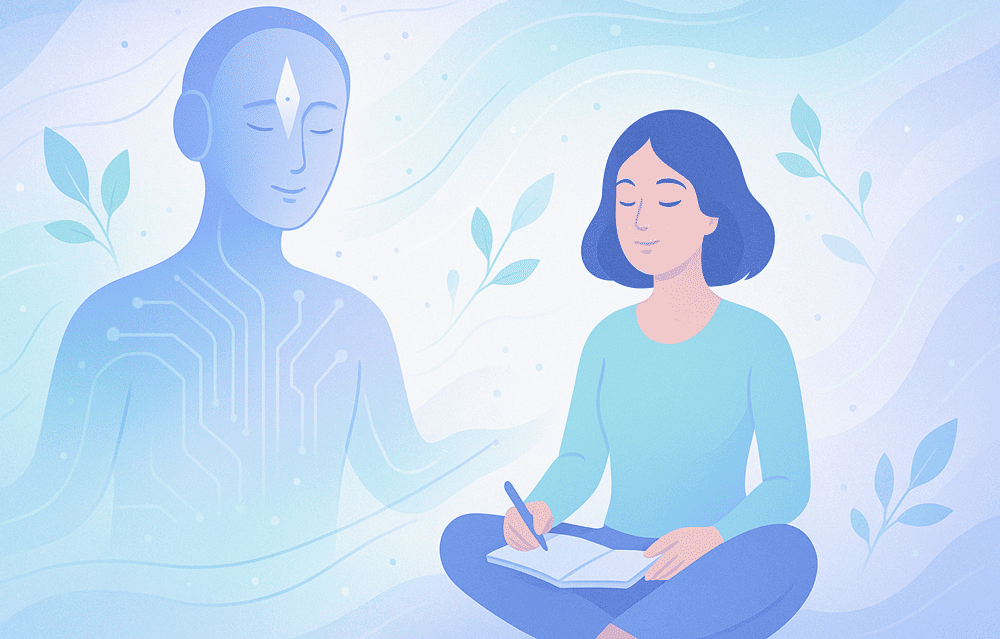
One size doesn’t fit all. That’s where personalized wellness AI outshines generic wellness apps. These platforms learn from individual behavior and tailor interventions accordingly.
Features of Personalized Wellness AI:
- Tracks emotional states through voice tone, typing speed, and engagement patterns.
- Recommends micro-breaks, breathing exercises, or reflective journaling.
- Integrates seamlessly into daily routines—Slack, MS Teams, or email.
Some systems even use voice analysis to detect rising anxiety and initiate coping suggestions. It’s proactive, not reactive.
“We used to think phone addiction was about willpower. Now we understand it’s about awareness and guided habit change—something AI can offer without judgment.”
Wellbeing Meditation Meets AI Coaching
Meditation has always been a powerful remedy for overthinking and distraction. But traditional meditation apps often sit untouched—ironically because users are too distracted to open them.
AI-enhanced wellbeing meditation tools are flipping that script.
How AI Enhances Meditation Practices:
- Suggests meditation based on real-time stress signals or usage patterns.
- Delivers personalized sessions aligned with emotional states (e.g., calming, energizing, grounding).
- Offers guided breathing or micro-mindfulness moments during peak digital fatigue hours.
These tools aren’t passive content libraries. They adapt and evolve with the user, encouraging consistency without pressure.
Traditional Tools vs. AI-Based Mindfulness Tools
| Feature | Traditional Tools | AI-Based Mindfulness Tools |
|---|---|---|
| Usage Tracking | Manual | Automated & Real-Time |
| Personalization | Low | High (based on behavioral patterns) |
| Engagement | Self-initiated | Proactive, Context-Aware |
| Integration with Work Tools | Rare | Frequent (Slack, Google Workspace, etc.) |
| Emotional Intelligence | None | Voice/Text Sentiment Recognition |
How Companies Are Using AI to Reduce Screen Fatigue
Forward-thinking companies are deploying AI for mental wellbeing as part of their digital wellness strategies. From tech startups to Fortune 500s, AI coaches are now being integrated to help employees reset digital habits.
Case Example: A Tech Firm’s Digital Detox Initiative
A mid-sized SaaS company partnered with an AI wellness platform to:
- Analyze peak stress hours.
- Deliver personalized wellbeing nudges.
- Recommend mindful phone breaks.
In just 6 weeks, employees reported:
- 21% reduction in non-work screen time.
- 32% improvement in post-lunch productivity.
- 48% reported feeling more “mentally present” during meetings.
Combating the Deeper Issues Behind Screen Overuse
Often, cell phone addiction is a surface symptom of deeper issues like social anxiety, chronic stress, or low engagement at work. AI tools—especially those offering AI CBT (Cognitive Behavioral Therapy)—are helping users unpack the emotions behind their compulsive behaviors.
AI CBT programs guide users through thought challenges, self-reflection, and journaling prompts. When paired with mindfulness, they create a more holistic approach—one that addresses the why, not just the what.
How AI Coaches Align with Workplace Mindfulness Initiatives
Many companies already promote workplace mindfulness through workshops or wellness days. But AI coaching extends that initiative by embedding support into everyday work life.
Instead of a once-a-month seminar, employees receive ongoing micro-coaching—right when they need it.
And when tied into broader programs like social anxiety solutions, AI acts as both preventive and responsive care—empowering users to manage attention, stress, and digital dependency.
Tips for Industry Leaders: How to Introduce AI-Based Wellness in Your Workplace
If you’re considering bringing AI for cell phone addiction into your organization, here are a few tips:
✅ Start with Awareness
- Share stats and real stories about digital fatigue.
- Use anonymous surveys to understand baseline screen habits.
✅ Choose the Right Tools
- Look for platforms offering personalized wellness AI, behavioral nudges, and mindfulness integration.
✅ Prioritize Privacy
- Ensure employee data is anonymous and ethically used.
✅ Make It Inclusive
- Offer coaching across all devices—phones, desktops, smartwatches.
✅ Track and Evolve
- Set engagement benchmarks and collect feedback to refine your approach.
Final Thoughts: Let Technology Heal, Not Harm
The irony of using AI to fix phone addiction is not lost on anyone. But it’s also a reminder that technology itself isn’t the enemy—it’s how we use it. By making our phones a source of mindfulness instead of mindless scrolling, we shift the narrative.
AI for cell phone addiction is more than a tech trend. It’s a practical step toward creating mentally healthier, more focused workplaces. And when combined with tools like wellbeing meditation, AI CBT, and personalized wellness AI, it becomes a powerful ally in reclaiming attention, reducing stress, and building healthier digital habits.
As the workplace continues to evolve, it’s time our wellness strategies evolve too.


